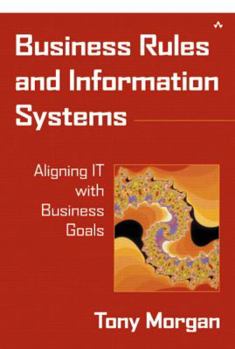Business Rules and Information Systems: Aligning It with Business Goals
Select Format
Select Condition 
Book Overview
Shows IT professionals how to specify what their systems need to do. This book provides an introduction to business rules, as well as a framework for integrating them into information systems. It... This description may be from another edition of this product.
Format:Paperback
Language:English
ISBN:0201743914
ISBN13:9780201743913
Release Date:March 2002
Publisher:Addison-Wesley Professional
Length:384 Pages
Weight:1.10 lbs.
Dimensions:0.7" x 6.3" x 9.3"
Customer Reviews
2 ratings
A helpful book for the Business Analyst
Published by Thriftbooks.com User , 18 years ago
If you are a Business Analyst and you've just been told your next project will use a Business Rules engine, you are no doubt wondering "how do I capture and document these Business Rules things"? This book is a great help for that - it explains where business rules sit relative to business process models and use cases (narratives), what they are and what types there are, and then outlines a method on how to go about capturing and documenting them. I am using the book for this purpose and its a good starting point; note that I am modifying some of the practices and documentation formats to suit the context of the project I'm working on. The author has no problem with this and in fact cheerfully suggests when it may be needed. There are also details about maintaining business rules over the lifetime of a system and some technical stuff (now looking to be somewhat dated). The extra bit of knowledge I would add (from the BA Book of Knowledge) is that if your project doesn't use a separate business rules engine or component, then don't bother capturing them separately but just do what you have done before and put the business rules in the relevant Use Case documentation. Note to the Technical Folk: this isn't the book for you as it's really for business analysts and managerial types and has very little implementation details (see the DROOLS open source project for an example of these details) If you do want to read it, borrow or interloan it via your local library.
Best introductory text on the subject
Published by Thriftbooks.com User , 22 years ago
This book introduces the concept and mechanics of business rules, and is essential reading for anyone involved in eliciting and writing requirements, or developing specifications. I want to disclose that I am a staunch advocate of business rules, so take this into consideration as you read this review.This is one of two books on the subject. The other book, Business Rules Applied by Barbara von Halle, is more suitable for an experienced practitioner or someone responsible for implementing business rules as an enterprise methodology. This book, however, focuses on the basics and addresses topics, such as object orientation and development, that are not found in von Halle's book. Both books are valuable, but to different audiences.What I like most about this book is that it painstakingly describes how to define business rules, and how to clearly and unambiguously describe them. Moreover, the approach given in this book employs the object constraint language, which is a part of the unified modeling language (UML) version 1.1. As such it shows how to integrate business rules into use cases, and to develop artifacts that align to organizations that are using UML or the Rational Unified Process, as well as object-oriented frameworks in general.My favorite chapters were 3, which is about defining business rules (getting them right) and 5, which covers controlling business rule quality. To me these are the keys to understanding and using business rules, and both chapters were clear and filled with examples. I also liked the appendix, which covered logic - another essential knowledge factor for analysts who are involved in requirements and specifications.If you're new to business rules or are exploring them, start here. Even though the von Halle book is better suited to experienced practitioners, I would still recommend this book to members of that audience who are working in object-oriented environments or are using UML. If you are also using UML, do consider also reading Alistair Cockburn's excellent book titled Writing Effective Use Cases because that book is completely consistent with the material in this one.





